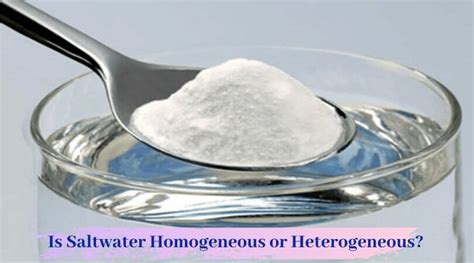Is Salt A Heterogeneous Or Homogeneous
Muz Play
Mar 30, 2025 · 4 min read

Table of Contents
Is Salt a Heterogeneous or Homogeneous Mixture? A Deep Dive into the Composition of Table Salt
The seemingly simple question of whether salt is a heterogeneous or homogeneous mixture opens a fascinating window into the world of chemistry and material science. While the answer might seem straightforward at first glance, a closer examination reveals a nuanced understanding of chemical composition, phase transitions, and the very definition of homogeneity. This article will delve deep into the properties of salt, exploring its structure, behavior under different conditions, and ultimately, definitively answering the central question.
Understanding Homogeneous and Heterogeneous Mixtures
Before we can classify table salt, we need to clearly define the terms "homogeneous" and "heterogeneous."
Homogeneous mixtures, also known as solutions, have a uniform composition throughout. This means that the different components are evenly distributed at a microscopic level. You cannot visually distinguish the individual components; they blend seamlessly. Examples include saltwater, air, and sugar dissolved in water.
Heterogeneous mixtures, on the other hand, have a non-uniform composition. The different components are visibly distinct and not evenly dispersed. Examples include sand and water, oil and water, and a salad.
The Composition of Table Salt (NaCl)
Table salt, chemically known as sodium chloride (NaCl), is an ionic compound, not a mixture in the strictest sense. This distinction is crucial. While we often talk about salt as being dissolved in water (a mixture), pure, dry table salt itself isn't a mixture of different substances. It's a crystal lattice structure formed from sodium (Na⁺) and chloride (Cl⁻) ions. These ions are held together by strong electrostatic forces, forming a highly ordered, repeating three-dimensional structure.
The Crystalline Structure of NaCl
The sodium and chloride ions are arranged in a cubic crystal lattice. Each sodium ion is surrounded by six chloride ions, and each chloride ion is surrounded by six sodium ions. This arrangement is incredibly regular and consistent throughout the entire crystal. There are no distinct regions of sodium ions separated from regions of chloride ions. This ordered structure is what gives salt its characteristic cubic crystal shape when allowed to grow undisturbed.
Examining Salt Under a Microscope
Even under high magnification, a single crystal of pure NaCl appears uniform. You wouldn't be able to distinguish individual sodium and chloride ions visually. This microscopic uniformity further reinforces the idea that pure NaCl is not a mixture but a single compound. However, commercial table salt often contains additives, and that's where the complexity begins.
The Influence of Additives in Commercial Table Salt
Commercial table salt rarely consists solely of pure NaCl. Manufacturers often add additives such as:
- Iodine: Added to prevent iodine deficiency, a crucial nutrient for thyroid health.
- Anti-caking agents: These substances prevent the salt from clumping together due to humidity. Examples include silicon dioxide and calcium silicate.
- Potassium chloride: Sometimes added as a substitute for sodium chloride for individuals on low-sodium diets.
These additives are usually present in very small quantities, but their presence changes the homogeneity of the salt. Depending on the evenness of the distribution of these additives, the commercial product might exhibit slight variations in composition at a microscopic level. However, it's important to note that these variations are often too minor to be easily noticeable to the naked eye.
Salt as a Solution: A Mixture Perspective
When salt is dissolved in water, it forms a homogeneous solution. The sodium and chloride ions dissociate and become evenly distributed throughout the water. At the macroscopic level, the saltwater appears uniform. However, at a microscopic level, the water molecules and the dissolved ions are distinct entities. This highlights the importance of scale when considering homogeneity.
The Impact of Impurities on Homogeneity
Even "pure" salt samples found in nature will contain small amounts of impurities. These impurities are typically other minerals or ions incorporated into the crystal lattice during salt formation. These impurities, while present, are generally present in trace amounts and don't significantly alter the overall homogeneity at a macroscopic level. The overall composition remains consistently salty. It's still predominantly NaCl, with only minor variations in mineral composition.
Conclusion: Pure Salt vs. Commercial Salt
To summarize:
-
Pure sodium chloride (NaCl) is not a mixture; it's a compound. Its highly ordered crystal lattice structure gives it a uniform composition throughout. Therefore, pure salt is homogeneous.
-
Commercial table salt, due to the presence of additives, is technically a heterogeneous mixture. While the additives are generally present in small quantities and evenly distributed enough that we consider it homogeneous for most practical purposes, the slight variations in composition at a microscopic level technically classify it as heterogeneous. However, the degree of heterogeneity is so minuscule that it’s often not practically significant.
This distinction highlights the importance of considering the context and scale when analyzing the homogeneity of a substance. While pure NaCl is definitively homogeneous, the commercial product we commonly use, with its additives, falls into a grey area, technically heterogeneous but functionally homogeneous for the vast majority of applications. The critical point is that the level of non-uniformity is extremely small and typically negligible.
Latest Posts
Latest Posts
-
Real Life Examples Of Linear Equations In Two Variable
Apr 01, 2025
-
What Does An Mean In Arithmetic Sequences
Apr 01, 2025
-
How To Find Pmf From Cdf
Apr 01, 2025
-
Area By Integration Problems With Solutions
Apr 01, 2025
-
What Do Carbohydrates Do For The Cell Membrane
Apr 01, 2025
Related Post
Thank you for visiting our website which covers about Is Salt A Heterogeneous Or Homogeneous . We hope the information provided has been useful to you. Feel free to contact us if you have any questions or need further assistance. See you next time and don't miss to bookmark.
